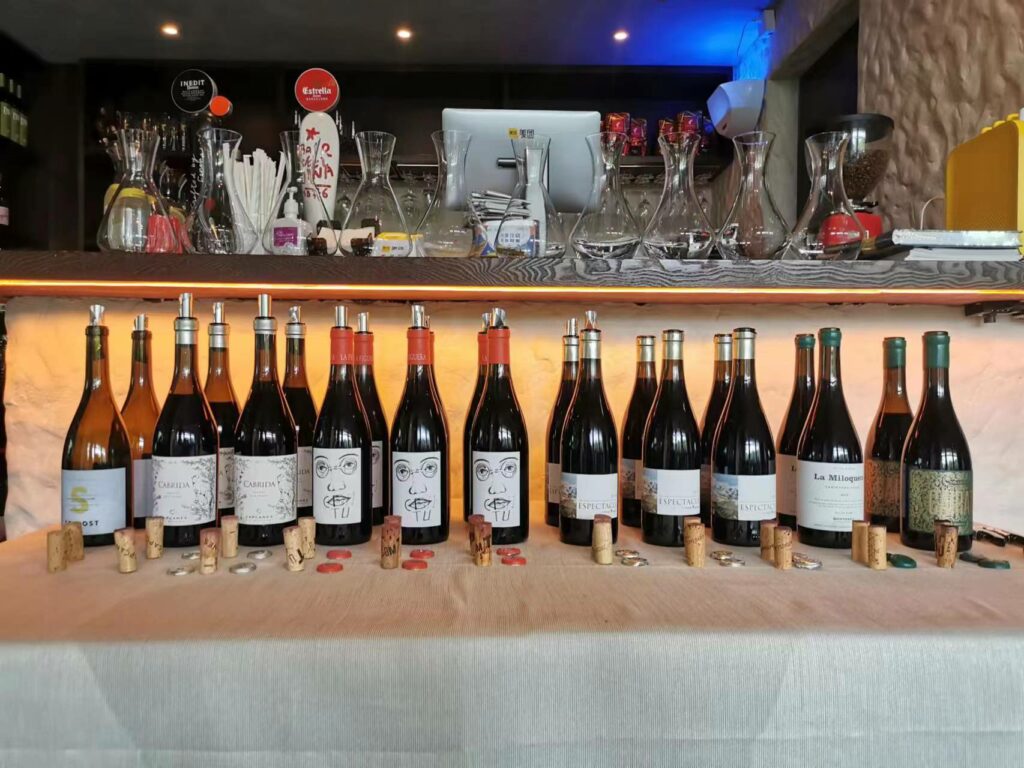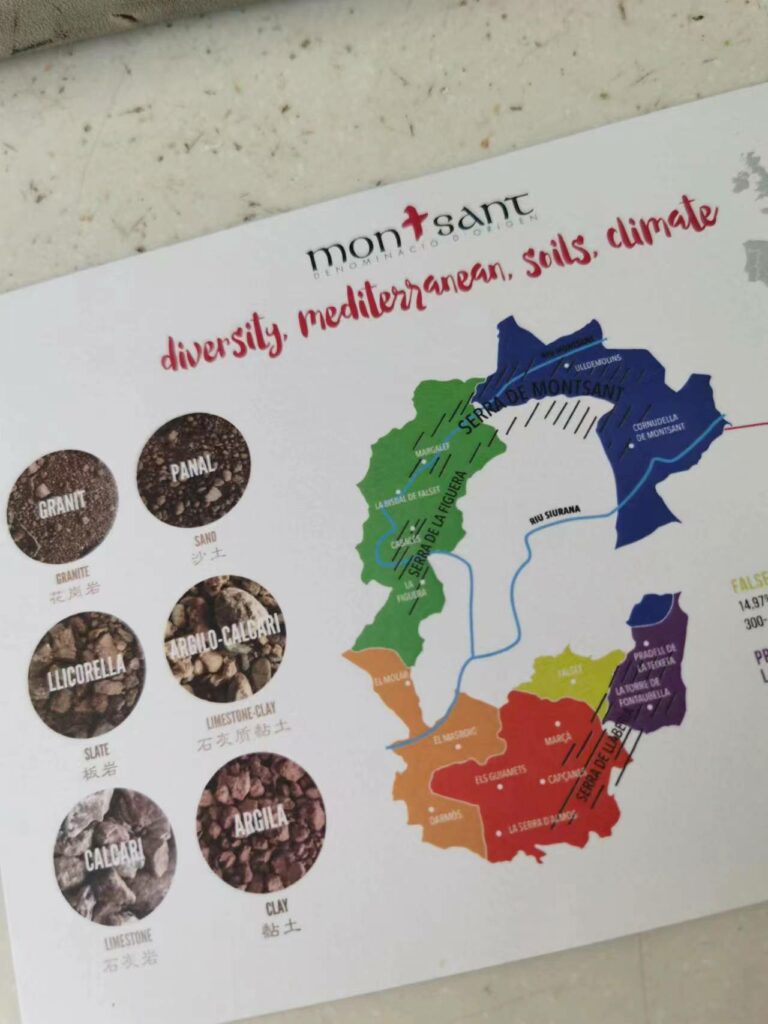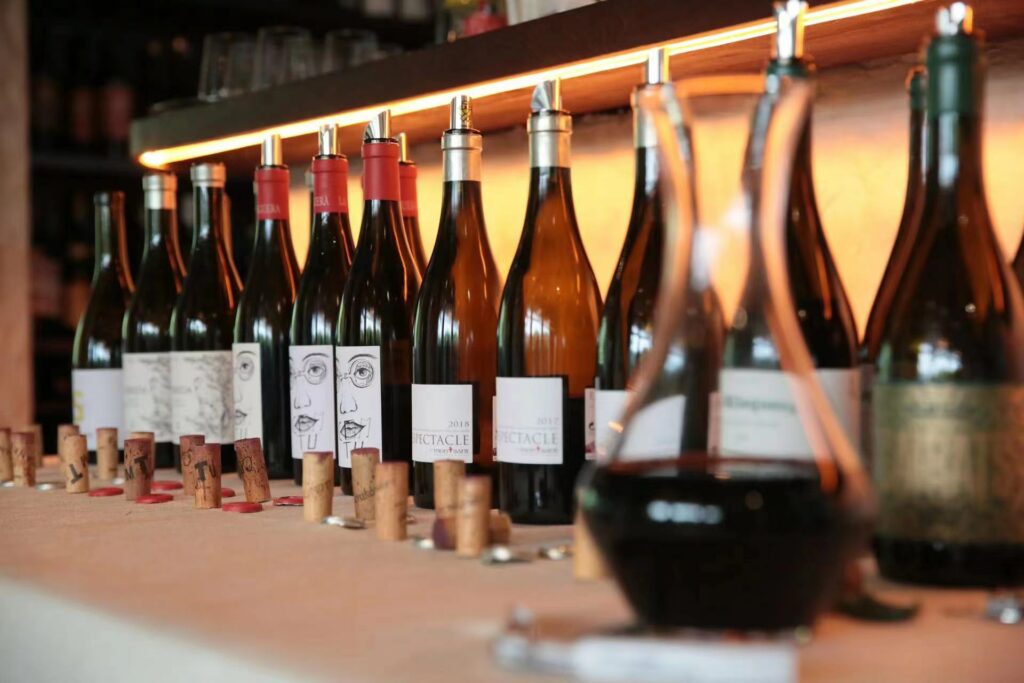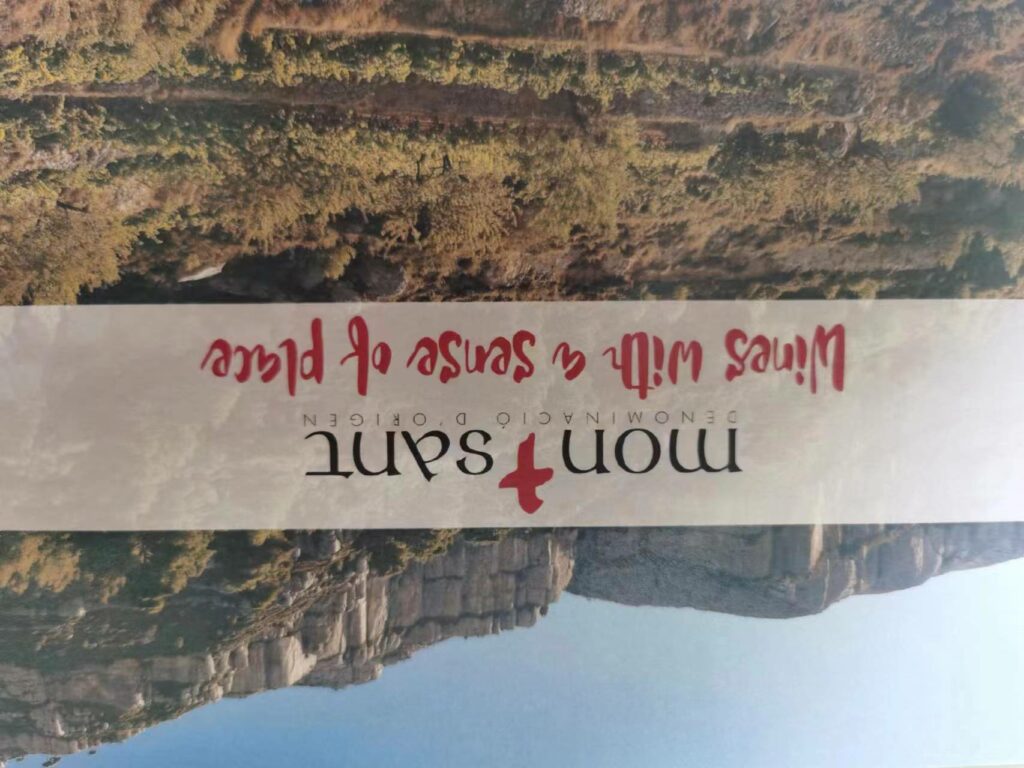Montsant is a C-shaped Spanish wine Appellation, or a Denominación de Origen (DO) in Spanish, located in Catalonia, in the country’s northern reaches. Montsant is only about 170 kilometers west of Barcelona and roughly 80 kilometers inland from the city of Tarragona to the northwest (in fact, Montsant was previously referred to as the Falset subzone of the Tarragona DO; it became a separate DO only in the early 2000s). And while the wines of the Monstant region are not (yet?) quite as famous as those of nearby Priorat (that Montsant encircles almost entirely), the area was once well-regarded for its wines. Thanks to the presence of the city Reus and the coast at Tarragona, Montsant wine was popular and exported already in the mid-nineteenth century. Unfortunately, phylloxera caused devastation in the vineyards here like everywhere else in Europe, and when winemaking restarted in the area it was mostly limited to larger cooperatives (readers might want to take note that the winery buildings of the Falset cooperative are especially beautiful, as they were designed by Cesar Martinell, a Gaudí disciple). At the same time, it needs to be recognized that the wines of Montsant have been rising fast in renown of late, especially since the establishment of the official DO in 2001. And, while there were, for example, only twenty-eight official wine cellars in 2002, these had increased to sixty already by 2020.

The Montsant terroir
Approximately 94% of Montsant’s wine production is red (of which 62% is exported outside Spain), made mostly from the Grenache -Garnatxa in Catalan, and you’ll see it written as such on most labels- and Carignan varieties, but white (mostly from Macabeo and white Grenache), rosé, sweet and even rancio-styled wines are produced too. (Also, Montsant is one of the few areas of Spain where kosher wines are made.)

Montsant takes its name from the local Montsant mountain range at the foothills and on the slopes of which the vineyards grow. The vines are planted on a variety of soils (ranging from the famous llicorella or slate and granitic sand, to limestone, to limestone-clay to chalky clay to clay) between 200-700 meters above sea level. The Denominacion extends over the territories of twelve communes and encompasses sixteen different villages such as Bisbal de Falset, Cabacés, Capçanes, Cornudella de Montsant, La Figuera, Guiamets, Marçà, Margalef, El Masroig, Pradell de la Teixeta, La Torre de Fontaubella, Ulldemolins, and portions of others. The whole area can be divided into subregions characterized by different geologies, mesoclimates (the climate of Montsant is classified as “Mediterranean” but with Continental influences, and it does differ within the Denominacion; furthermore, the natural barrier provided by the mountain range reduces the Mediterranean Sea influence and guarantees high diurnal temperature variations), altitudes and exposures ranging from warmer, lower-lying stretches in the south-west corner that slope down towards the Ebro River and higher, wilder areas such as around the village of La Figuera (which, at roughly 575 meters in altitude and higher, is one of the highest-situated territories in the region). Therefore, Montsant can be divided into various subregions, each with its range of altitudes, climates, and soil types. These are, proceeding in a circular fashion from the southeast to the northeast as to draw a semi-circle or “C” letter open to the right:
- Pradell de la Teixeta, La Torre de Fontaubella (average daily temperature 14.02 degrees Celsius; average annual rainfall: 667.20 mm; average altitude: 330-420 meters above sea level; slope gradient average: 30%)
- Falset (average daily temperature 14.97 degrees Celsius; average annual rainfall: 649.90 mm; average altitude: 300-400 meters above sea level; slope gradient average: 15%)
- Capçanes, Els Guiamets, Marçà, La Serra d’Almos (average daily temperature 16.05 degrees Celsius; average annual rainfall: 525 mm; average altitude: 100-500 meters above sea level; slope gradient average: 14%)
- El Molar, El Masroig, Darmós (average daily temperature 15.55 degrees Celsius; average annual rainfall: 440.70 mm; average altitude: 50-300 meters above sea level; slope gradient average: 17%)
- La Figuera, Cabacés, La Bisbal, Margalef (average daily temperature 13.37 degrees Celsius; average annual rainfall: 395.23 mm; average altitude: 300-500 meters above sea level; slope gradient average: 32%)
- Cornudella de Montsant, Ulldemolins (average daily temperature 14.33 degrees Celsius; average annual rainfall: 484.74 mm; average altitude: 400-700 meters above sea level; slope gradient average: 27%)

The wines in this tasting
The wines in this tasting were all tasted in Shanghai where I work and live this April (2023) courtesy of LuPing, representative of the DO Montsant in China who organized a brilliant tasting of wines from the region.
Cellers Cairats.
Cellers Cairats 2015 Samsó Col lecció Montsant 94
Bright deep red. Strawberry, blackberry, mountain herbs and violet on the perfumed, enticing nose, complicated by delicate hints of smoked lard. Then dense and juicy at the same time, with suave red fruit and herbal flavours that are very well-delineated and nicely focused, the finish is bright and long. Now this is lovely, and drinking splendidly right now even though, at eight years out, it still drinks like a much more youthful wine than it is. Given its fruitiness and very smooth structure, it will match effortlessly with many grilled and boiled meats, both white and red. I really liked this! 100% Carignan. Readers should note that “Samsó” is the Catalonian name by which locals call Carignan (at times you will also see wine bottles with the word “Sinsó”: that’s not a typo, but a similar-looking name to Samsó that locally refers to Cinsault). Drinking window: 2023-2030.
Cellers de Capçanes.
Cellers de Capçanes 2018 Cabrida Calissa Montsant 91+
Dark red-ruby: noticeably darker than the 2017. Deep, sweet aromas and flavours of ripe red and black fruit with hints of balsamic oils, milk chocolate, spicecake and herbs. Creamy and suave in the mouth but not over the top, boasting enough freshness to remain light and lively as it glides across the palate on a long smooth finish. Clearly made in a much warmer year than the 2017, this red is creamy as opposed to the more floral 2017 version, but each wine will have its fans. 100% Grenache planted at about 500 meters above sea level on limestone-rich soil; the wine is aged in 300 liters tonneaux. Drinking window: 2023-2028.
Cellers de Capçanes 2017 Cabrida Calissa Montsant 93
Bright medium red with ruby tinges. Violet, rosehip, cranberry, herbs and unroasted coffee beans on the lifted nose. Then also bright in the mouth, with juicy red fruit flavours (redcurrant, strawberry, sour red cherry) that are nicely extended on the long vibrant finish by a whiplash of harmonious acidity. No blockbuster, this is a really lovely wine that will prove very food-friendly and that, though it’s 100% Grenache, actually shares a lot of similarities with a fresh, easy-going, floral Cabernet Franc wine. Drinking window: 2023-2028.
Cellers Sant Rafel.
Cellers Sant Rafel 2020 Solpost Blanc Montsant 92
Luminous medium dark straw yellow. Perfumed, intense aromas and flavours of yellow flowers, apple, pear, and herbs, complicated by a hint of balsamic oils. The finish is long and clean, and features a pleasantly glyceral mouthcoating texture. This lovely 100% Grenache Blanc is really excellent, in a cool-climate, fresh, style (the garbinada wind helps create a cool microclimate for the vines to ripen in). The vines are planted on limestone soil in the Pradell de la Teixeta subregion, at about 400 meters in altitude, and the wine is aged in about 15% used oak and the rest in stainless steel. Drinking window: 2023-2028.
Cellers Vendrell Rived.
Cellers Vendrell Rived 2019 Carinyena Vella La Miloquera Montsant 90+
Deep saturated ruby. Aromas and flavours are dominated by wild herbs, candied violet, coffee and some red fruits. Youthfully chewy and still somewhat monolithic presently, this needs to spend time in a good cellar to develop fully and show all it has to offer. Cellers Vendrell Rived is a family-run winery founded in 2000 with now roughly twenty-five hectares planted to Carignan and Grenache as the winery specializes in red wines, though it also makes a lovely white wine from the local Macabeo and Grenache Blanc varieties. The grapes are organically farmed and the wine aged for about twelve months in French oak barrels. Drinking window: 2023-2028.
Clos Mogador.
Clos Mogador 2019 Com Tu Montsant 93+
Deep moderately saturated red. Fresher and more vibrant, but also less creamy, than the 2018, this boasts pretty aromas and flavours of red fruit, pink and blue flowers with some earthy spiciness thrown in the mix for added interest. The finish is long and bright. I prefer the lifted penetrating qualities of this nicely balanced, very harmonious wine, compared to the creamier, slightly heavier 2018, but I understand why some wine lovers will prefer the suaver, more textured 2018 (which, in the La Figuera district of Montsant at least, and unlike in nearby Priorat, was a warm year). This 2019’s bright features are partly the result of the decision made to harvest slightly earlier in an effort to make a less rich style of wine than those of the previous, all rather hot and dry vintages. The decision to pick earlier was made easier by rainfall hitting during harvest. Drinking window: 2025-2032.
Clos Mogador 2018 Com Tu Montsant 91
Vivid full red. Tar, licorice and ripe red cherries dominate on the nose and the slightly syrupy mouthfeel. Closes long and smooth, but a little one-dimensional. The grapes are planted between 500-600 meters above sea level on a mostly red clay and limestone soil. About half the must was macerated for ten twelve days, while the other half of the must spent 35-40 days in contact with the skins; it was then aged in 4000 and 5000 Liters barrels for eighteen months. Don’t be fooled by the characteristics of the 2018 vintage in nearby Priorat, where it was cool and rainy: in the La Figuera district of Montsant, 2018 was actually a dry and warm year, and the region’s wines showcase this well. Drinking window: 2025-2032.
Clos Mogador 2017 Com Tu Montsant 93
Good full red. Violet, sweet spices, milk chocolate and strawberry on the bright nose. Then bright and juicy on entry, with solid redcurrant and earthy flavours in the middle that are fresh and juicy but nicely supported by very suave soft tannins on the back end. The long finish features repeating notes of sweet spices and red fruit nicely framed by citrussy, limestone acidity. This very pretty wine strikes me as a wine that falls somewhere in between the 2018 and the 2019 Com Tu in style. Mostly Grenache, with some Carignan, Syrah, and Cabernet Sauvignon, this wine was aged for a little less than the 2018 (twelve months versus the eighteen months of the 2018) given the characteristics of the 2017 growing season weather that tended to give more politely-styled, fragrant wines. Drinking window: 2023-2029.
Clos Mogador 2018 Espectacle del Montsant Montsant 95
Good deep red. Very spicy with strong notes of cedar and pine dominating aromas of dark plum, orange peel and truffle. Then similar flavours on the palate, but with a slightly baked, tired quality to the mouthfeel. The aftertaste is long and rich, but is also marked by some alcohol-derived heat that won’t be for everyone. My suggestion is to let this age further in a good cellar to allow this wine to showcase all it has to offer, which is plenty; at that point in time, the wine will likely merit two to three points more than my current score shows (hence the plus sign attached to it). Made from 80-120 years old Grenache vines planted on slate-rich soils in an amphitheater in the La Figuera district at roughly 6.00 meters above sea level, it is an extremely famous Spanish wine that has a real cult following. As good as this 2018 wine is, and it certainly is an excellent wine, it is my view that it has also been slightly overrated by some wine scribes, so beware. My advice is to taste before you buy. Drinking window: 2027-2035.
Clos Mogador 2017 Espectacle del Montsant Montsant 94
Bright medium-dark red. Clean, fresh, red fruit and spices on the nose and in the mouth, plus a touch of balsamic oils, underbrush and candied violet for added complexity. Then nicely harmonious with reticent slightly jammy red and blue fruit, candied flowers and licorice pastille flavours that are nicely complemented by a subtle earthiness. The close is long and suave, with polished tannins providing support. Currently drinking very nicely, but will prove much better in about four to five years and last well for another decade after that. Drinking window: 2027-2035.
Clos Mogador 2012 Espectacle del Montsant Montsant 99

Luminous good full red. Inviting aromas of red and blue fruit, underbrush, orange peel, mint and flint. Smooth, earthy and spicy flavours of red cherry, dark plum, red licorice, coconut sweet pipe tobacco, Oriental woods, and coffee cream are complex and deep, and nicely lifted by harmonious acidity. Very clean fresh and juicy, this extremely well-balanced red is an absolute joy to drink. Knockout stuff and to my taste, the best Espectacle ever made. Drinking window: 2023-2032.


 中文
中文



